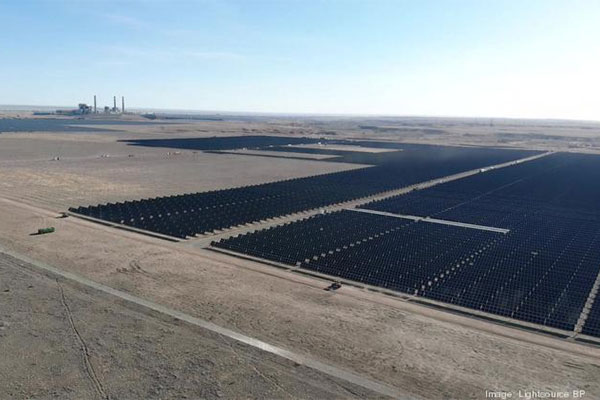One of the largest solar facilities east of the Rockies has now officially launched in Pueblo, Colorado, and will help produce some of the world’s most environmentally friendly steel. Developed by Lightsource BP, the $285 million, 300-megawatt Bighorn Solar array will replace nearby coal power plants in supplying electricity to Pueblo’s steelworks.
The project consists of more than 750,000 solar panels covering 18 acres and was borne out of concerns about rising electricity rates after Xcel Energy announced closing two local coal plants ahead of schedule.
In response to these closures, Evraz, the Russian mining conglomerate that owns Pueblo’s steel mill, was initially planning to relocate out of state in a bid to find more reliable and affordable energy prices. This would have been economically and culturally devastating for a community that’s relied on steel production, including recycled rails, seamless pipe, and reinforcing bar, for 140+ years.
Luckily, thanks to the mill’s switch to solar technology, no such disruption has to take place. The steel mill will enjoy guaranteed electricity prices until 2041 due to a power purchase agreement (PPA) owned by Xcel Energy. This agreement is particularly advantageous right now as the world grapples with what is likely to be the last energy crisis of the fossil fuel era.
While coal played a crucial role in Pueblo’s formative years as an industrial hub, the city’s power plants are now old, inefficient, highly polluting, and incapable of keeping up with today’s quickly evolving energy market. Contrasting the decline of coal is the rise of solar, which has enabled Pueblo’s steelworks to undergo a significant upgrade and expansion — one that will see hundreds of permanent, well-paying jobs added to the existing roster of around 1000.
The state government of Colorado approved millions in tax incentives for the new development as part of a broader effort to maintain the economic viability of the region as a production hub.
The replacement of coal with solar as the steel mills’ primary energy source is indicative of the industry’s broader decarbonization trend. Steel currently accounts for between 7-9% of global carbon emissions, making it the most carbon-intensive industrial sector on the planet. Luckily, renewable technologies, combined with other processes like scrap metal recycling, can significantly reduce emissions.
Solar energy will supply the Evraz plant, which utilizes electric arc furnaces, with just shy of 90% of the energy it requires — amounting to 434,000 tonnes of carbon savings annually. That’s the equivalent of taking more than 92,000 gasoline-powered vehicles off the road each year!
The importance of decarbonizing heavy industries like steel can’t be understated, especially as production looks likely to explode in the near future.
According to the International Energy Agency (IEA), global steel demand will grow by more than a third by 2050. Many of the catalysts behind this projection are related to renewable energy and cleantech initiatives.
For example, steel is commonly used in photovoltaic systems, solar thermal power plants, onshore and offshore wind turbines, electric vehicles, high-speed train cars and rails, and more.
Commenting on this project, Abigail Ross Hopper, president and CEO of the Solar Energy Industries Association, said, “we have an important opportunity to create more projects like this one all over the country as we strive to get 30% of U.S. electricity from solar by 2030.”
By providing well-paying union jobs to the local community, reliable energy prices to the towns’ steelworks, and reduced air pollutants and greenhouse gas emissions, solar energy will breathe new life, opportunity, and wealth into the city of Pueblo. Additionally, it will aid Colorado in protecting its natural environment and eco-tourism industry, something long threatened by coal and other carbon-intensive fuel sources.
Other jurisdictions and manufacturers should consider following suit, as sustainable steel has the potential to propel economies to new heights while addressing the most severe environmental issues of today.













Comments